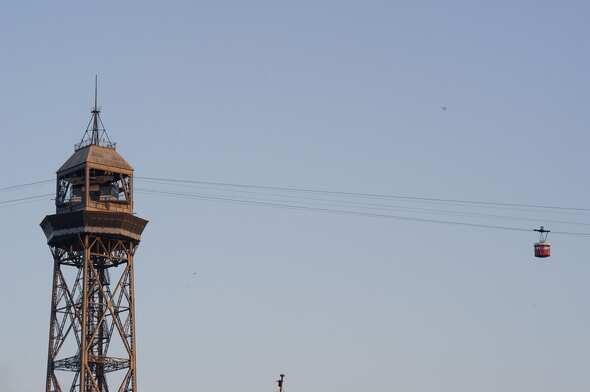Barceloneta
A stroll through Barceloneta
La Barceloneta, "Little Barcelona", has a long and rich history. Today, it is a vibrant and touristy neighborhood, full of restaurants, tapas bars, chiringuitos, nightlife, shops, hotels, and of course, its beaches. But for a long time, it was the traditional district of sailors and fishermen. Mediterranean colors and delicious seafood restaurants. It’s a must-see stop before heading to the beach.
How to Get to Barceloneta
Barceloneta is a neighborhood in the city of Barcelona, located about 1.5 km east of Plaça de Catalunya. It is famous for its beach, Barceloneta Beach, one of the most popular in the city. Located in the northeastern part of Barcelona, the district is bordered by the Mediterranean Sea to the east, the Port of Barcelona to the south, the Vila Olímpica neighborhood (Olympic Port) to the west, and the Ciutadella Park to the northwest.
Barceloneta may seem centrally located, but it’s actually just a bit off the main hub. To get there by public transport, take the metro or the bus:
By metro: Take line L4 (yellow) and get off at Barceloneta station. Once outside, you’re just a few minutes’ walk from the beach.
By bus: Take lines V19, 39, 45 or 59 and get off at the Barceloneta stop. From there, it’s a 5-minute walk to the neighborhood.
Tourist Bus: The red line drops you off at the History Museum of Catalonia, right at the entrance to the district.
>> Hotels near Barceloneta Metro
Barceloneta Map
The History of Barceloneta
The Barceloneta neighborhood was built in the 18th century on land reclaimed from the Mediterranean Sea, intended to house the fishermen of the city of Barcelona. The streets and buildings were designed to provide easy access to the sea and allow fishermen to store their nets.
Over the years, the neighborhood developed into a major center for fishing and salt production. However, in the 19th century, Barcelona began to grow rapidly, and industrial areas started to expand into the surrounding neighborhoods. This led to increasing pollution in the port and in Barceloneta, causing the gradual closure of fishing businesses and the transformation of the neighborhood into an industrial zone.
In the 1980s and 1990s, the city of Barcelona launched a major urban renewal project to rehabilitate Barceloneta and restore its original charm. The streets were renovated, historical houses and buildings were restored, and new facilities were built to encourage tourism.
Barceloneta Today
Today, Barceloneta is a lively and tourist-friendly neighborhood, with plenty of outdoor activities, seafood restaurants, trendy bars, boutiques, and hotels. Barceloneta Beach is one of the city’s most popular beaches, drawing numerous visitors every year.
Barceloneta has inspired many artists over the years, including writers such as Carlos Ruiz Zafón, Eduardo Mendoza, Francisco González Ledesma, and Manuel Vázquez Montalbán, whose famous private detective Pepe Carvalho is imagined wandering through the narrow streets of the neighborhood at night.
Barceloneta has also served as a filming location for many movies, including "Vicky Cristina Barcelona" by Woody Allen, "Biutiful" by Alejandro González Iñárritu, and "Pa Negre" by Agustí Villaronga.
The Beaches of Barceloneta

Among all the beaches of Barcelona, Barceloneta’s are the most popular due to their proximity to the city center. They are greatly appreciated by both locals looking for a quick break and tourists. You can stroll along the sea on foot or by bike, use sports facilities, enjoy a drink at one of the many chiringuitos on the beach, or simply relax by the sea.
> Barceloneta Beach is the most famous beach in Barcelona, located right next to the Barceloneta neighborhood. It stretches for 1,100 meters and is equipped with showers, toilets, sunbeds, and umbrellas. The beach is very busy in summer, but quieter spots can be found if you walk a bit further.
> Sant Miquel Beach is located west of Barceloneta Beach. It’s smaller and less crowded, but still equipped with showers and toilets, and good for sports.
> San Sebastián Beach lies further west of Sant Miquel Beach. It can be easily spotted thanks to the nearby W Hotel. It also features showers and toilets.
> Somorrostro Beach is located to the east of Barceloneta Beach (toward the Olympic Port). It also has showers and toilets. It's less crowded than Barceloneta Beach, making it ideal for those seeking a bit more peace—though that’s relative in peak tourist season ;-).
What to See in Barceloneta
Here are some places to discover > Also check out our recommendations for great restaurants and the shops. That’s also part of discovering a city.
History Museum of Catalonia

The History Museum of Catalonia offers a captivating journey through the key moments of Catalan history, from Prehistory to the present day. Located in the elegant Palau de Mar building by the sea, it combines authentic artifacts, reconstructions, and interactive displays to reveal Catalonia’s identity, struggles, and culture. Its rooftop terrace also offers a stunning view over the Port of Barcelona. The museum is located at the entrance of the Barceloneta district.
Plaça de Pau Vila, 3, 08039 Barcelona, Spain
Paid entry – interior accessible
Metro: L4 – Barceloneta Station
The Port Cable Car

The Port Cable Car connects Torre de Sant Sebastià in Barceloneta with Miramar Tower on Montjuïc Hill. In service since 1931, it glides over the Port of Barcelona at more than 70 meters high, offering spectacular views of the sea, Las Ramblas, the Gothic Quarter, and the city rooftops. A short but unforgettable ride that links the beach to Montjuïc with a breathtaking panorama.
Torre Sant Sebastià, Passeig Joan de Borbó, 88, 08039 Barcelona, Spain
Paid entry – panoramic cabin ride across the port
Metro: L4 – Barceloneta Station